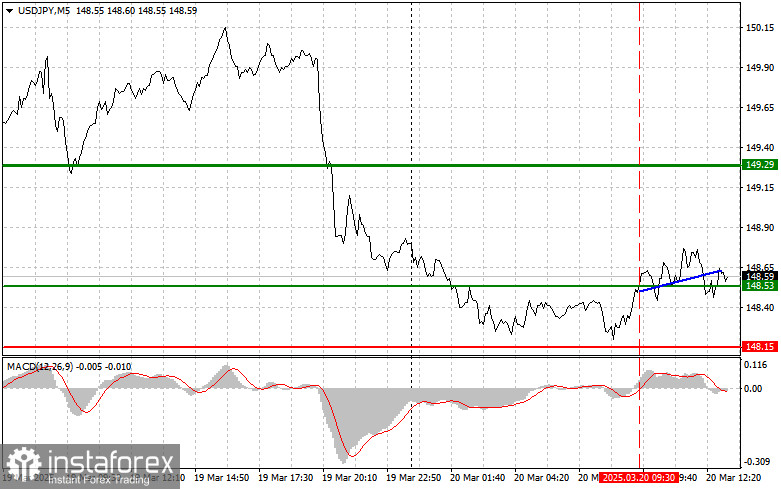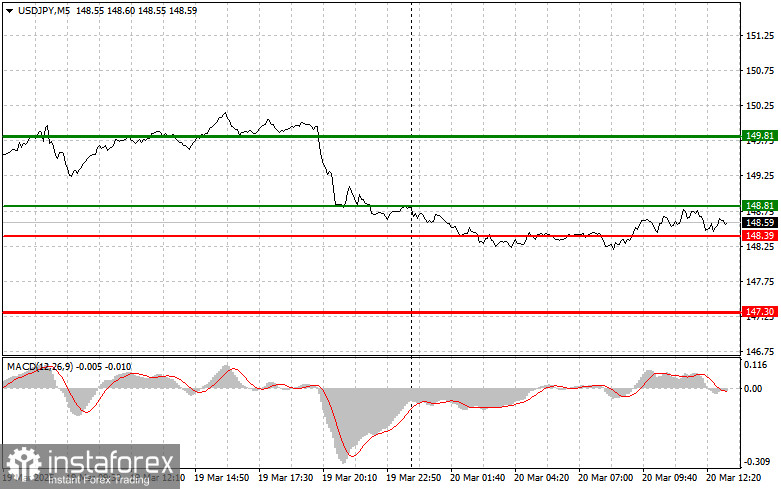Trade Analysis and Recommendations for the Japanese Yen
The 148.53 price test occurred when the MACD indicator was just starting to move upward from the zero mark, confirming a correct entry point for buying the dollar. As a result, the pair gained only 20 points.
The further dollar movement will depend on the U.S. economic data releases, including initial jobless claims, the Philadelphia Fed Manufacturing Index, and the current account balance. Close attention to these macroeconomic indicators will help traders gain a clearer understanding of the U.S. economy and predict the dollar's further trajectory. A rise in jobless claims could indicate an economic slowdown and weaken the dollar.
The Philadelphia Fed Manufacturing Index, which reflects industrial sector activity in the region, is also an important indicator. An increase in this index is typically seen as positive for the dollar, while a decline may signal economic weakness. The current account balance, showing the difference between exports and imports of goods and services, also plays a role but has less influence than the first two indicators.
A strong fundamental backdrop would help USD/JPY recover. Otherwise, pressure on the dollar will intensify.
Regarding intraday strategy, I will primarily rely on Scenario #1 and Scenario #2.

Buy Signal
Scenario #1: I plan to buy USD/JPY today if the price reaches 148.81 (green line on the chart), targeting a rise to 149.81 (thick green line on the chart). At 149.81, I will exit long positions and open sell trades, expecting a 30-35 point retracement. A bullish correction could support the pair's growth. Important! Before buying, ensure the MACD indicator is above zero and just starting to rise.
Scenario #2: I also plan to buy USD/JPY if there are two consecutive tests of the 148.39 level, while the MACD indicator is in the oversold zone. This would limit the pair's downward potential and trigger a bullish reversal. The price could rise toward 148.81 and 149.81.
Sell Signal
Scenario #1: I plan to sell USD/JPY after breaking below 148.39 (red line on the chart), expecting a quick decline in the pair. The key target for sellers will be 147.30, where I will exit short positions and immediately open buy trades, expecting a 20-25 point retracement. Selling pressure could emerge at any moment today. Important! Before selling, ensure the MACD indicator is below zero and just starting to decline.
Scenario #2: I also plan to sell USD/JPY if there are two consecutive tests of the 148.81 level, while the MACD indicator is in the overbought zone. This would limit the pair's upward potential and trigger a bearish reversal, leading to a decline toward 148.39 and 147.30.

Chart Explanation:
- Thin green line – entry price for buy trades.
- Thick green line – estimated price where Take Profit can be placed, as further growth above this level is unlikely.
- Thin red line – entry price for sell trades.
- Thick red line – estimated price where Take Profit can be placed, as further decline below this level is unlikely.
- MACD indicator – traders should consider overbought and oversold zones when entering the market.
Important Note for Beginner Traders:
New traders in the Forex market should exercise caution when making entry decisions. It is best to stay out of the market before major fundamental reports to avoid sudden price swings. If you decide to trade during news releases, always place stop-loss orders to minimize losses. Without stop orders, you risk losing your entire deposit very quickly, especially if you trade large volumes without proper money management.
Remember, successful trading requires a clear trading plan, like the one provided above. Spontaneous decisions based on current market movements often lead to losses for intraday traders.
 English
English 
 Русский
Русский Bahasa Indonesia
Bahasa Indonesia Bahasa Malay
Bahasa Malay ไทย
ไทย Español
Español Deutsch
Deutsch Български
Български Français
Français Tiếng Việt
Tiếng Việt 中文
中文 বাংলা
বাংলা हिन्दी
हिन्दी Čeština
Čeština Українська
Українська Română
Română

